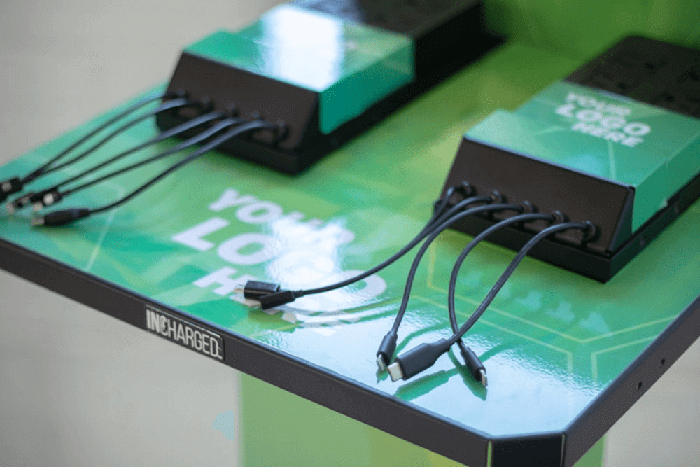Intelligent Energy has created small cartridges that can harness hydrogen, enabling cell phone charging stations even when there are no sources of electricity available. The company began developing energy technology for larger projects such as structures and automobiles and has since expanded into creating fuel cells for consumer electronics.
Their first fuel cell product designed for consumer electronics, Upp, provides about five full charges for a mobile device with its phone charging stations. Hydrogen is stored in a container, atomically bound to a metal hydride powder – As it combines with air, it releases energy. The device can power anything usually charged via USB. For smartphones and tablets, there is an application designed to conserve energy, monitor remaining power, and direct users to the nearest spot to exchange used cartridges.
In time, the Intelligent Energy expects the fuel cells to become small enough to be embedded in consumer electronics. Intelligent Energy is currently working on cutting costs down to $5 per cartridge – the fuel cells will be crucial to developing areas where electricity may be scarce, but in these areas, income is often low. They hope to make it easy for cartridges to be exchanged, in time partnering with telecommunication companies to include fuel cells with mobile services. In fact, Upp was launched last November in Africa with Etisalat, premiered in January at the Consumer Electronics Show in Las Vegas with Brookstone, and launched in February at Mobile World Congress in Barcelona.
Green, renewable energy at a low cost – sounds like a winning solution to us! We look forward to seeing how this developing technology can be brought to large-scale phone charging stations in the future.
We have discussed in another blog how Lithium-Ion batteries may just be seeing their last days are the new alternates are available in the market and the researchers are working on bringing the solid-state batteries to the end consumer.
We will discuss a different type of energy here, the fuel cells. Let’s unwrap the fuel cells layer by layer.
What are Fuel Cells?
In simple words; Fuel cells are the type of batteries that generate electricity through an electrochemical reaction.

A fuel cell helps in converting chemical potential energy mainly present in Hydrogen gas and Oxygen gas as fuel because the chemical energy of Hydrogen is very strong to produce clean electricity. These fuel cells are called PEM (Proton Exchange Membrane) Cells. PEM cells help in generating heat, water, and electricity through Hydrogen gas and Oxygen gas through electrolysis (PEM or alkaline electrolysis).
Unlike in coal-burning power plants, IC (Internal Combustion) Engines, and nuclear power plants, the PEM cells don’t produce the harmful by-products. They produce clean energy.
PEM cells are made of several layers of the membrane of various materials.
– Membrane Electrode Assembly
– Catalyst Layers
– Gas Diffusion Layers
Membrane Electrode Assembly (MEA)
MEA further contains the anode and the cathode poles.
The anode is the negative pole of the fuel cell. The electrons that are freed from the hydrogen are conducted by anode for them to be used further in the external circuit. The channels are etched into it for equally dispersing the hydrogen gas over the catalyst’s surface.
The Cathode is the positive pole of the fuel cell. Similar channels are etched into cathode that disperse the oxygen on the catalyst’s surface. The cathode conducts the electrons to the catalyst back from the external circuit.
Catalyst Layers
Catalyst layers are present on the anode side as well as the cathode side of the membrane. Catalyst layer assists in the reaction between Oxygen and Hydrogen in these phone charging stations.
The Gas Diffusion Layers
The GDLs are placed outside the catalyst layers and they help the reactants reach the catalyst layer. The GDLS generally contains the carbon paper.
Depending on the fuel used, the different types of cells are; direct methanol fuel cells, solid oxide fuel cells, polymer electrolyte membrane fuel cells, molten carbonate fuel cells, alkaline fuel cells, phosphoric acid fuel cells, and reversible fuel cells.
The working and structure of each cell type are different.
The Current State of Fuel Cells
Understanding the concept of different fuel cells is easy. However, it is tough to manufacture the cost-effective, durable, and efficient fuel cells and scientists are continuously working to make the fuel cells available for commercial use on a large scale so they can replace the traditional batteries and heat engines or generators.
They have developed various sizes of fuel cells to check efficiency, durability, and sustainability. Each fuel cell developed had disadvantages and advantages over other types. However, no model is cheap enough for the consumer market and ready to replace traditional energy solutions. There have been a few successes where the PEM fuel cells have replaced the traditional batteries such as UAVs (Unmanned Aerial Vehicles) or drones, automobile, and stationary power. The large scale market penetration is yet to witness by the consumers.
The benefits of fuel cells over traditional sources of energy are;
- Fuel cells are more efficient than the traditional IC combustion engines, gas engines, and diesel engines.
- Fuel Cell operations are silent hence they can be used inside the buildings in corporate offices and hospitals where they can replace the generators placed outside.
- There are low to no emissions in fuel cells as the only by-product in the fuel cells is water.
- Elimination of greenhouse gases in the complete cycle
- Fuel cells reduce the dependency on traditional fuels such as gas and oil.
- Fuel cells don’t have grid dependency
- A few fuel cell types have low heat transmission which is best for military use
- Fuel cells with high-temperature operations can be used to produce electricity as well as heat for residential purposes.
- Fuel cells with the same capacity as the batteries have more operating time.
- As the structure of fuel cells is simple so they are easy to maintain.
- Fuel cells offer various scalability options as there are many fuel types and electrolyte types are available.
- Fuel cells have flexibility in the choice of fuel and electrolyte type
With so many benefits that are cost-friendly, environment-friendly, user-friendly, it is likely to get welcomed with warm hearts by the consumers. And, service providers like us who are in the cell phone charging station business are ready to accept the change and mould the product line for better tomorrow. If any energy-based solution is about serving people better and saving the environment, we are always up for it.
InCharged’s Phone Charging Stations
InCharged’s cell phone charging stations are also made simple structure yet very effective usage. With slight tweaks as per the technological advancements, we can have a completely different line of products serving the same purpose.
If in the near future, the solid-state batteries or the fuel cells are likely to dominate the energy storage and solutions’ market, which we also wish happens soon, then we can transform the current cell phone charging stations that are already placed/installed to several locations. Our technology and product are future-proof.
InCharged’s cell phone charging stations will still be leading the market for providing charging and advertisement solutions in a single product. The scalability opportunity with InCharged is huge. If you haven’t experienced it, this is the time to do it.
Explore the cell phone charging stations and advertisement solutions from InCharged.
Source: Cisco, Intelligent Energy, Upp



